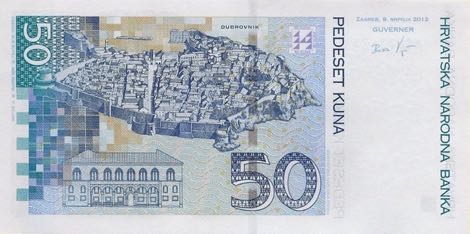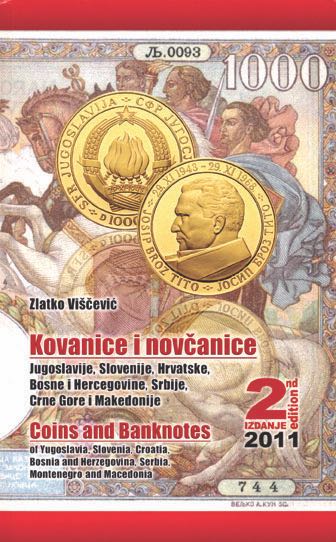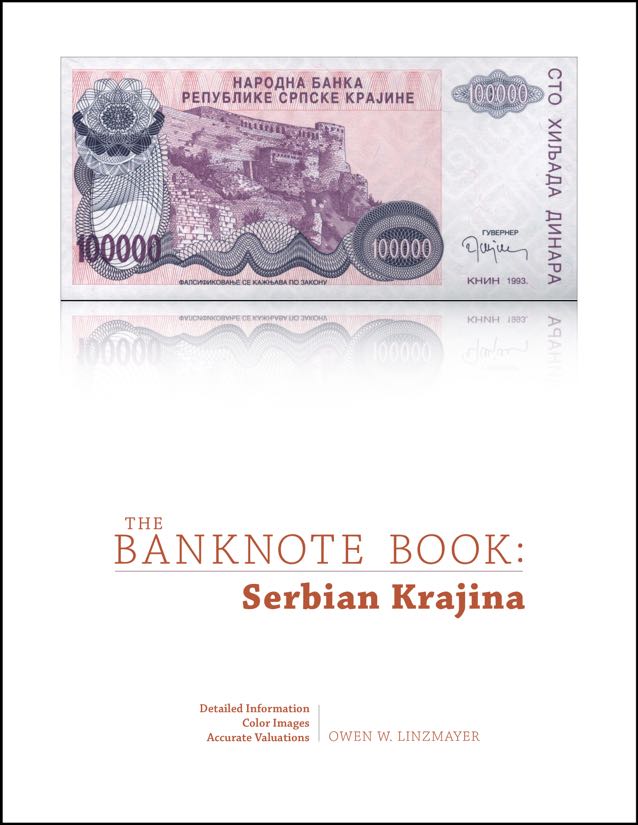Croatia
Croatia new sig/date (09.07.2012) 50-kuna note (B504b) confirmed
06 11, 2017 05:11 Category: Europe


Like B504a, but new signature and new date (9. SRPANJ 2012). Prefix/suffix A/S. Intro: 25.09.2017.
Courtesy of Robert Mol.
Croatia new 20-kuna commemorative confirmed
22 06, 2014 10:20 Category: Europe


According to a post on the bank's web site, on 30 May 2014, the Hrvatska Narodna Banka (Croatian National Bank) issued a new 20-kuna commemorative note. The note is like HNB B3, but with DVADESETA OBLJETNICA HRVATSKOGA NOVCA KUNE I LIPE 2014 (Twentieth anniversary of the Croatian currency Kuna and Lipa 2014) on the left side of the banknote, at the position of the watermark, microprinted 34 times in continuous vertical lines, creating a rectangle with some letters and numbers bolded to form number "20" and the inscription "OBLJETNICA" printed in iridescent colour in three lines over the rectangular base.
The Croatian National Bank also produced up to 40,000 sets of uncirculated 10- and 20-kuna commorative banknotes in special folders and sold them for 52 kuna each as numismatic products.
Courtesy of Claudio Marana, Mojmir Cerny, and Zlatko Viscevic.
Book review: Coins and Banknotes of Yugoslavia, Slovenia, Croatia, Bosnia and Herzegovina, Serbia, Montenegro and Macedonia

Coins and Banknotes of Yugoslavia, Slovenia, Croatia, Bosnia and Herzegovina, Serbia, Montenegro and Macedonia
Zlatko Viščević, 1173 pages, soft cover, 192 x 120 mm, black and white illustrations, Croatian and English, ISBN 978-953-56890-0-3, US$52 / €40 (free shipping), kin2.orders@gmail.com
Download the free sample chapter: Coins and Banknotes of the Kingdom of Yugoslavia.
Reviewed by Owen W. Linzmayer 7962
As author Zlatko Viščević mentions in the introduction to his impressive new catalog, collecting banknotes from the area of the former Yugoslavia can be quite challenging due to the large number of notes issued over the years. Compounding the problem is the Serbo-Croatian text on these notes and the complicated history of the region, both of which may be unfamiliar to many collectors. This new catalog doesn’t attempt to explain the tumultuous politics of the past three centuries, but is an invaluable addition to the reference library of anyone who specializes in collecting notes from this part of the world.
The first edition of this catalog was published in 2007. The second edition covers regular and commemorative notes issued in the intervening years, goes into greater depth in the descriptions, and now also includes special, fantasy, and private issues. In short, if you already own the first edition and like it, you’ll definitely want to buy the much-improved and expanded second edition.
Coins and Banknotes’ title spells out exactly what’s inside. The first half of the book is devoted to coins, the second half to notes, with chapters for the seven countries in each section. Within the chapters, the coins and notes are listed chronologically by denomination, which makes it easy to locate a particular piece and track changes over time, but at the expense of presenting complete families with common or complementary designs.
Each note type listing contains the denomination, catalog number, cross-references to Pick numbers and other specialized catalogs, reduced-size illustrations of the front and back, description of design elements and security features, and finally a list of varieties, with checkboxes for tracking your collection. Each variety is assigned a six-level rarity rating, and has values in euros for up to four levels of condition. Some notes also have auction results at the bottom of the page, though the values and results don’t always agree. Occasionally there are inset illustrations of details which determine varieties. These are useful in most cases, but sometimes the differences aren’t obvious due to the small size or lack of color in their reproduction.
Specialized collectors will appreciate the comprehensive lists of prefixes, as well as the inclusion of specimen and replacement notes in the variety tables, not to mention the assortment of “irregular issues” (color trials, partial proofs, etc.) and private/fantasy notes covered separately. While there isn’t much explanatory text regarding these issues, anyone interested in pursuing further research can consult the bibliography of source books and web sites at the end of each chapter.
The longer passages of prose in the catalog are presented in both Croatian and English, but the descriptions of the notes and their varieties are in Croatian only, which is a little frustrating if you care about such details and don’t want to rely upon Google Translate. Fortunately the English text everywhere else in the book is good enough that it’s easy to overlook the minor typos and understand the gist of the intended meaning.
One complaint I have about the catalog is its size. This is a bulky, compact tome measuring a whopping 55 millimeters thick, and heavy enough to break a toe if dropped on a foot. I would have preferred the coin and banknote sections split into two separate volumes, both printed in a larger format. As it is, the small black and white illustrations don’t do justice to the beauty of the notes, and the tiny text is hard to read if your eyesight isn’t perfect.
With this second edition, Zlatko Viščević has created a solid reference for collectors of notes of Yugoslavia and its constituent republics from 1849 to 2011. Coins and Banknotes delivers a dense helping of numismatic information at price that can’t be beat.
Croatia new sig/date (09.07.2012) 100- and 200-kuna notes confirmed
09 07, 2013 08:07 Category: Europe

100 kuna, 9. SRPANJ 2012 (09.07.2012). Like HNB B5, but new date and new signature (Boris Vujcic). Intro: 01.07.2013.
200 kuna, 9. SRPANJ 2012 (09.07.2012). Like HNB B6, but new date and new signature (Boris Vujcic). Intro: 01.07.2013.
Courtesy of Zlatko Viscevic.
Croatia new sig/date (09.07.2012) 10- and 20-kuna notes confirmed
23 03, 2013 14:02 Category: Europe

On 18 March 2013, the Croatian National Bank issued new 10- and 20-kuna banknotes like HNB B2 (P38) and B3 (P39) respectively, but with new dates (9 SRPANJ 2012) and new signature (Boris Vujcic). Details in Croatian.
Courtesy of Mirko Pistan and Ivan Martinović.
Serbian Krajina chapter of The Banknote Book is now available
14 06, 2012 17:11 Category: The Banknote Book | Europe

The Serbian Krajina chapter of The Banknote Book is now available for individual sale and as a free download to subscribers.
This 11-page catalog covers notes issued by the Република Српска Крајина / Republika Srpska Krajina (Republic of Serbian Krajina) in 1992, and the Narodna Banka Republike Srpske Krajine (National Bank of the Republic of Serbian Krajina) from 1992 to 1994. Revised 16 August 2015.
Each chapter of The Banknote Book includes detailed descriptions and background information, full-color images, and accurate valuations. The Banknote Book also features:
- Sharp color images of note’s front and back without overlap
- Face value or date of demonetization if no longer legal tender
- Specific identification of all vignette elements
- Security features described in full
- Printer imprint reproduced exactly as on note
- Each date/signature variety assigned an individual letter
- Variety checkboxes for tracking your collection and want list
- Red stars highlight the many notes missing from the SCWPM
- Date reproduced exactly as on note
- Precise date of introduction noted when known
- Replacement note information
- Signature tables, often with names and terms of service
- Background information for historical and cultural context
- Details magnified to distinguish between note varieties
- Bibliographic sources listed for further research
Subscribe to The Banknote Book
If you collect the entire world or a large number of countries, buying a subscription is the best deal because it's less expensive than buying chapters individually, and it entitles you to every chapter currently available as well as everything published—or revised (click here to see the Change Log)—during the term of your subscription.

Sign up for Email Notifications
If you would like to receive email notifications whenever a new chapter of The Banknote Book is published, please join the email list by clicking the button below.

Book Review: Coins and Banknotes of Yugoslavia, Slovenia, Croatia, Bosnia and Herzegovina, Serbia, Montenegro and Macedonia

Coins and Banknotes of Yugoslavia, Slovenia, Croatia, Bosnia and Herzegovina, Serbia, Montenegro and Macedonia
Zlatko Viščević, 1173 pages, soft cover, 192 x 120 mm, black and white illustrations, Croatian and English, ISBN 978-953-56890-0-3, US$52 / €40 plus shipping, www.hrvatskanumizmatika.net
Download the free sample chapter: Coins and Banknotes of the Kingdom of Yugoslavia.
Reviewed by Owen W. Linzmayer 7962
As author Zlatko Viščević mentions in the introduction to his impressive new catalog, collecting banknotes from the area of the former Yugoslavia can be quite challenging due to the large number of notes issued over the years. Compounding the problem is the Serbo-Croatian text on these notes and the complicated history of the region, both of which may be unfamiliar to many collectors. This new catalog doesn’t attempt to explain the tumultuous politics of the past three centuries, but is an invaluable addition to the reference library of anyone who specializes in collecting notes from this part of the world.
The first edition of this catalog was published in 2007. The second edition covers regular and commemorative notes issued in the intervening years, goes into greater depth in the descriptions, and now also includes special, fantasy, and private issues. In short, if you already own the first edition and like it, you’ll definitely want to buy the much-improved and expanded second edition.
Coins and Banknotes’ title spells out exactly what’s inside. The first half of the book is devoted to coins, the second half to notes, with chapters for the seven countries in each section. Within the chapters, the coins and notes are listed chronologically by denomination, which makes it easy to locate a particular piece and track changes over time, but at the expense of presenting complete families with common or complementary designs.
Each note type listing contains the denomination, catalog number, cross-references to Pick numbers and other specialized catalogs, reduced-size illustrations of the front and back, description of design elements and security features, and finally a list of varieties, with checkboxes for tracking your collection. Each variety is assigned a six-level rarity rating, and has values in euros for up to four levels of condition. Some notes also have auction results at the bottom of the page, though the values and results don’t always agree. Occasionally there are inset illustrations of details which determine varieties. These are useful in most cases, but sometimes the differences aren’t obvious due to the small size or lack of color in their reproduction.
Specialized collectors will appreciate the comprehensive lists of prefixes, as well as the inclusion of specimen and replacement notes in the variety tables, not to mention the assortment of “irregular issues” (color trials, partial proofs, etc.) and private/fantasy notes covered separately. While there isn’t much explanatory text regarding these issues, anyone interested in pursuing further research can consult the bibliography of source books and web sites at the end of each chapter.
The longer passages of prose in the catalog are presented in both Croatian and English, but the descriptions of the notes and their varieties are in Croatian only, which is a little frustrating if you care about such details and don’t want to rely upon Google Translate. Fortunately the English text everywhere else in the book is good enough that it’s easy to overlook the minor typos and understand the gist of the intended meaning.
One complaint I have about the catalog is its size. This is a bulky, compact tome measuring a whopping 55 millimeters thick, and heavy enough to break a toe if dropped on a foot. I would have preferred the coin and banknote sections split into two separate volumes, both printed in a larger format. As it is, the small black and white illustrations don’t do justice to the beauty of the notes, and the tiny text is hard to read if your eyesight isn’t perfect.
With this second edition, Zlatko Viščević has created a solid reference for collectors of notes of Yugoslavia and its constituent republics from 1849 to 2011. Coins and Banknotes delivers a dense helping of numismatic information at price that can’t be beat.
Croatia chapter of The Banknote Book is now available
09 05, 2011 08:57 Category: The Banknote Book | Europe

The Croatia chapter of The Banknote Book is now available for individual sale and as a free download to subscribers.
This 13-page catalog covers notes issued by the Independent State of Croatia from 1941, Croatian National Bank from 1943, Republic of Croatia from 1991, National Bank of Croatia from 1993, and Croatian National Bank from 2001. Revised 19 July 2016.
Each chapter of The Banknote Book includes detailed descriptions and background information, full-color images, and accurate valuations. The Banknote Book also features:
- Sharp color images of note’s front and back without overlap
- Face value or date of demonetization if no longer legal tender
- Specific identification of all vignette elements
- Security features described in full
- Printer imprint reproduced exactly as on note
- Each date/signature variety assigned an individual letter
- Variety checkboxes for tracking your collection and want list
- Date reproduced exactly as on note
- Precise date of introduction noted when known
- Replacement note information
- Signature tables, often with names and terms of service
- Background information for historical and cultural context
- Details magnified to distinguish between note varieties
- Bibliographic sources listed for further research
Subscribe to The Banknote Book
If you collect the entire world or a large number of countries, buying a subscription is the best deal because it's less expensive than buying chapters individually, and it entitles you to every chapter currently available as well as everything published—or revised (click here to see the Change Log)—during the term of your subscription.

Sign up for Email Notifications
If you would like to receive email notifications whenever a new chapter of The Banknote Book is published, please join the email list.


